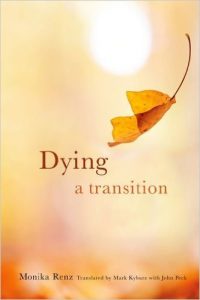 Dying: A Transition (End of Life Care: A Series) – by Monika Renz
Dying: A Transition (End of Life Care: A Series) – by Monika Renz
Reviewed by David Lorimer
Last month Peter Fenwick and I both spoke at a conference on death and dying in Elche, Spain. In our own ways we were articulating our understanding of death as transition rather than extinction. Soon after I returned I received this seminal book on the death process by Monika Renz, a Swiss psychotherapist, music therapist, theologian and spiritual care-giver who has been head of the psycho-oncology unit at St Gallen Hospital since 1998. She bases this quite remarkable phenomenological study on accompanying 1,000 cancer patients through death. The book is full of spiritual insight and sensitive understanding and should be required reading for anyone in the field and for the general reader seeking a more profound insight into the death process and its relationship to spiritual transformation in terms of transcending ego-identity. There is a wealth of significant detail for the attentive reader, aspects of which we would be wise to apply to our own situation in the present. My copy is heavily underlined.
Renz’s model presents three fundamental phases of dying corresponding to anthropological work carried out by Arnold van Gennep and Victor Turner on rites of passage: pre-transition, transition through an inner threshold and post-transition. In this way she goes beyond the five stages of Kubler-Ross, which are mainly about coming to terms with death. While dying we still have a choice of orientation towards having or being, fear or trust, power or relatedness, but the process itself as described is inexorable, stripping away the pretensions and structures of the ego and dramatically transforming perception. After the ordeal and affliction of facing the primal fear of dissolution (not normally part of NDE reports), patients emerge into a space of peace, acceptance, dignity and tranquillity characterised by connectedness and even luminosity. It is at once a spiritual and archetypal process. Renz takes the reader in detail through these phases, adding advice about what helps and giving individual case histories as well as summaries of the main features of each phase.
For the caregiver this means learning to listen and understand a new language of symbolism, becoming sensitive to the immediate spiritual needs of the patient. Caregivers will find the book extraordinarily helpful and affirming, all the more so if they share the author’s spiritual outlook. A key theme is dignity, which Renz feels is an inviolable feature of being human, regardless of one’s physical state; in this respect, it is more than self-determination. Spiritually and theologically, she believes, we are part of a large whole, and death provides an encounter with the numinous, the dying of the I into the Thou, into the Light, into the I Am. At the first stage, reconciliation with family members is very important as well as letting go of false masks. Music can play a significant role and the dying are open to sublime perceptions beyond the physical world.
Renz then gives more detail on metaphors of transition as well as sites of transition in terms of fear, struggle, acceptance, family processes and maturation. There are abysses, tunnels, storms and chasms, all of which can be traversed. Then after the crossing is light and peace, the overcoming of division. She observes that those to whom faith means trust and affirmation are better able to navigate the process, but that dogmas need to be let go of. Caregivers and family members need to respect the wish to depart but they can empathise with blocks that may prevent departure or processes that will hasten it. Renz’s sensitive and occasionally dramatic interventions often enable her patients to move to the next stage.
Renz reports and says little about the afterlife, preferring to focus on the dying process – one might have expected some mention of deathbed visions as part of the transformation of perception. However, she does touch on three aspects of the beyond: backwards or forwards, relationship vs being and the question of a higher order of meaning – suffering and redemption. She states in her poetic epilogue that we all find our way home, falling into trust. In all of this there are important messages for the living about dying (to the ego) before you die and arriving at a state of reconciliation through forgiveness, if necessary. Individualistic self-sufficiency is ultimately an illusion: we are deeply connected to life and to each other, and in dying we become very dependent, surrendering ourselves to the transformative power of the death process. Still, as she says, we act and are acted upon. This powerful book plumbs the existential depths of our ultimate transformation.
